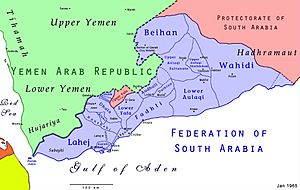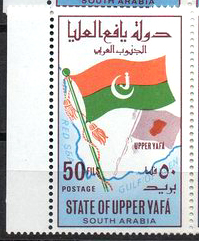Upper Yafa facts for kids
Quick facts for kids State of Upper Yafa
يافع العليا
Yāfi‘ al-‘Ulyā |
|||||||
|---|---|---|---|---|---|---|---|
| State of the Protectorate of South Arabia | |||||||
| c. 1800–1967 | |||||||
 Map of the Federation of South Arabia |
|||||||
| Capital | Mahjaba | ||||||
| Area | |||||||
|
• 1967 est.
|
1,600 km2 (620 sq mi) | ||||||
| Population | |||||||
|
• 1967 est.
|
35,000 | ||||||
| Government | |||||||
| • Type | Confederal Sultanate | ||||||
| • Motto | إِنَّ اللَّهَ يَأمُرُ بِالعَدلِ وَالإِحسَانِ 'Inn Alllah yamur bialeadl wal'iihsan "Indeed, Allah commands justice and grace" |
||||||
| Historical era | 20th century | ||||||
|
• Established
|
26 December | ||||||
|
• Disestablished
|
29 November 1967 | ||||||
|
|||||||
Upper Yafa (also called Upper Yafa'i) was a state in the southern part of the Arabian Peninsula. It was officially known as the State of Upper Yafa. This area is now part of modern-day Yemen.
Upper Yafa was like a group of smaller states that worked together. It was part of the British Aden Protectorate and later the Protectorate of South Arabia. The state was led by the Harharah family. Its main town, or capital, was Mahjaba. This small town was located on a hill about 50 kilometers northeast of Habilayn.
The leader, called the Sultan of Upper Yafa, didn't have much power over the smaller areas within his state. These smaller areas, called sheikdoms, had their own agreements with the British. They could also choose not to follow the Sultan's rules. The Sultan's power grew only when there was a big problem that threatened all the states. Then, they would unite under him. This means Upper Yafa was more like a military team than a single, strong country.
Contents
History of Upper Yafa
The Yafa'i people have lived in the mountains near Aden for a very long time. Upper Yafa was formed in the 1700s. It included several smaller areas known as sheikhdoms. These were Al-Busi, Al-Dhubi, Al-Hadrami, Al-Muflihi, Al-Mausata, Na'wah, and Rubeitein.
British Influence and Challenges
In 1895, Sultan Qahtan bin Umar became the leader. The British government didn't have much to do with Upper Yafa until 1903. At that time, they wanted to mark the border in the northeast. They made agreements with some of the sheikhdoms, with Sultan Qahtan as the main leader. However, when they tried to mark the border in one area, a fight broke out. This stopped the border marking for a while.
In 1904, Sultan Qahtan bin Umar was removed from power by his own people. This happened because of his agreement with the British. The British government later tried to help him get his position back.
Over the years, there were many changes in leadership and agreements. The British tried to keep peace and control the area. For example, in 1906, a leader named Ali Muhsin Askar caused trouble by knocking down a border marker. He lost his payment from the British until he apologized.
Changes in Leadership
Sultan Qahtan died in 1913 without getting his leadership back. His son, Sultan Umar, took over. The British didn't fully recognize him at first. They gave him time to prove himself. In 1919, he stepped down, and his uncle Salih became Sultan. The British recognized Salih in 1920.
In 1919, troops from the Imam of Sanaa (a leader from another part of Yemen) took over some areas of Upper Yafa. The local tribes worked together to push them out of one area in 1928.
Sultan Salih bin Umar stepped down in 1927. His son, Sultan Muhammad bin Salih, became the new leader. The British government recognized him. By 1931, it was thought that about 80,000 people lived in Upper Yafa.
Exploring the Region
Before 1925, Europeans had not explored Upper Yafa. Colonel M.C. Lake of the British Indian Army explored the area. He wanted to learn more about it and find places for planes to land. In 1925, he helped create a small army of local fighters. These fighters would help the British if there were conflicts with the Imam of Yemen.
End of Upper Yafa
Between 1955 and 1957, there were some uprisings against the British in Upper Yafa. These were stopped by the British. In 1959, some tribal leaders, with help from the Mutawakkilite Kingdom of Yemen, rebelled against the Sultan. The British Royal Air Force helped stop this rebellion by bombing the area.
Unlike some other states in the region, Upper Yafa did not join the Federation of South Arabia in the 1960s. It remained a separate area within the Protectorate of South Arabia.
The Upper Yafa Sultanate officially ended in 1967. This happened when the People's Republic of South Yemen was formed. South Yemen later joined with North Yemen in 1990 to create the country of Yemen we know today.
Leaders of Upper Yafa
Upper Yafa had different leaders over time, first called Sheikhs and then Sultans.
Sheikhs of Upper Yafa
- c.1730 – 1735: `Ali ibn Ahmad Al Harhara
- c.1735 – 1750: Ahmad ibn `Ali Al Harhara
- c.1750 – 1780: Salih I ibn Ahmad Al Harhara
- c.1780 – 1800: `Umar I ibn Salih Al Harhara
Sultans of Upper Yafa
- c.1800 – 1810: Qahtan I ibn `Umar ibn Salih Al Harhara (1st time)
- c.1810 – 1815: `Umar II ibn Qahtan ibn `Umar Al Harhara
- c.1815 – 1840: Qahtan I ibn `Umar ibn Qahtan Al Harhara (2nd time)
- c.1840 – 1866: `Abd Allah ibn Nasir ibn Salih Al Harhara
- 1866 – 1875: al-Husayn ibn Abi Bakr ibn Qahtan Al Harhara
- 1875 – 28 Apr 1895: Muhammad I ibn `Ali ibn Salih ibn Ahmad Al Harhara
- 1895 – 1903: Qahtan II ibn `Umar ibn al-Husayn Al Harhara
- 4 Dec 1903 – 1913: Salih II ibn `Umar ibn al-Husayn Al Harhara (1st time)
- 1913 – 1919: `Umar III ibn Qahtan ibn `Umar Al Harhara
- 1919 – 1927: Salih II ibn `Umar ibn al-Husayn Al Harhara (2nd time)
- 1927 – 1948: Umar IV ibn Salih ibn `Umar Al Harhara
- 1948 – 29 Nov 1967: Muhammad II ibn Salih ibn `Umar Al Harhara
Postage Stamps from Upper Yafa
The Sultanate of Upper Yafa issued its own postage stamps in September 1967. This happened even though the capital, Mahjaba, didn't have working postal services at the time.
An artist named Bruce Grenville has also created his own special stamps for Upper Yafa.
Many other stamps were made, but not by the official government. These were created even after Upper Yafa was no longer a state. You can find information about these stamps in special stamp catalogs.
See also
- List of Sunni dynasties
- Lower Yafa
- Protectorate of South Arabia




